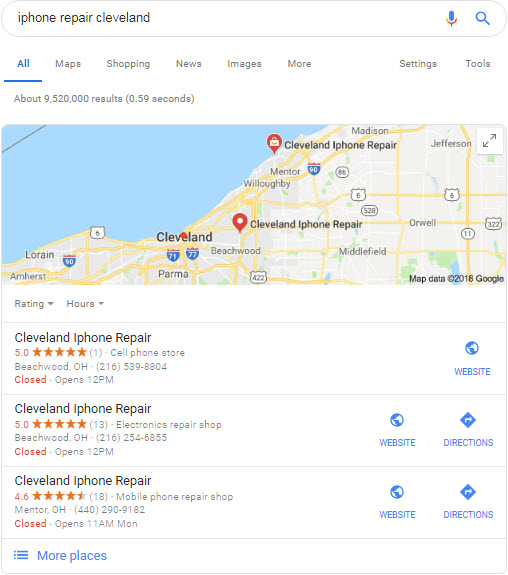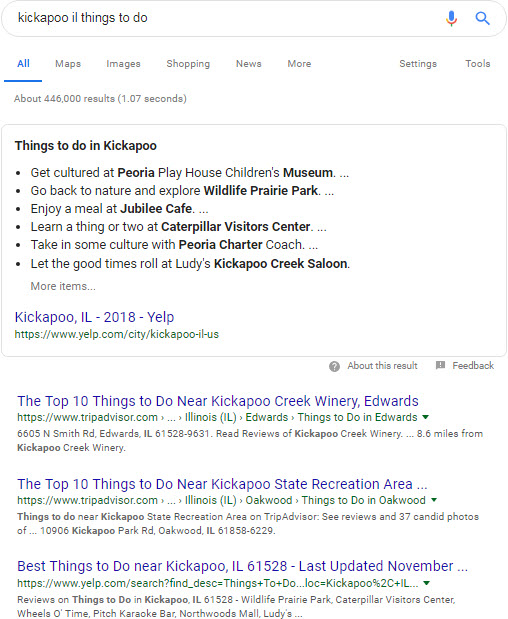It’s trickier than you think.
You can monitor competitors’ rankings and links until you’re cross-eyed. You can study them with SEMRush, Moz, Alexa , and other tools until hens grow teeth. The insights you get from those activities can have value, and may be a good use of your time, but trying to dissect a competitor’s rankings is pointless unless first you’ve determined the right competitor to dissect.
First you need to figure out who’s most likely to rank well long-term, and who probably gets customers from that visibility.
I suppose there’s no way to know for certain how effective competitors’ local SEO efforts are unless you see several years of their ledgers and Google Analytics numbers. Still, I’ve been part of local SEO efforts that have amounted to nothing more than blips and bumps in rankings/traffic, and I’ve had my hand in efforts that also brought big and lasting gains in business and profit. High-payoff local SEO campaigns tend to have some qualities in common.
Below are some ways you can be pretty sure a competitor is doing local SEO that works in the ways that you’d want yours to work. I doubt any single competitor of yours checks all the boxes, but an SEO-smart competitor will meet many of the criteria. That competitor is worth grabbing ideas from and maybe trying to reverse-engineer. The below points will give you a sense of which local competitor(s) you can follow up the rankings rather than into a rabbit hole.
Your competitor’s probably doing effective local SEO if your competitor has:
1. Ranked well for more than a couple of months. Newly-opened businesses or businesses that appear out of the blue often get some visibility in the Google Maps results for no apparent reason other than they’re new. But those businesses often don’t stay up there long-term.
2. Good visibility for search terms that aren’t too similar to the name of the business. For better and for worse, the business name does affect local rankings. If your competitors rank for terms stuffed into their Google My Business names, you can probably undo that advantage. If they rank for terms that are part of their real businesses names, good for them, but that doesn’t mean the rest of their local SEO is worth studying.

3. Good visibility for a range of search terms. Unless you only care about ranking for one service, product, or category of search term, you probably can’t glean much from a one-hit wonder.
4. More than one page that ranks well. A page on a business’s site can bob up and down in the search results constantly. You don’t want all your visibility riding on one page, so you’d probably like more than one page on your site to ride high. You may learn the most from the competitor who’s most consistent. Which Olympic athlete would you rather be: the one with one gold medal, or the one who’s always somewhere on the podium, event after event and year after year?
5. Solid organic rankings – not just rankings on the local map. If your competitors seem to have only Google Maps / 3-pack rankings, much of that visibility may be based on their locations (specifically their distance to customers). The location is a big factor. Now, maybe they have a more-prime address than you’ve got, and that may help them on the local map, but that doesn’t mean their local SEO effort has much else to tell you. Sometimes the organic results are where the real action is.

6. “Conversion” (or “money”) pages that rank well. If your competitors have crusty blog posts from 2009, or “Ultimate Guides,” or rogue PDFs, or category pages that rank for competitive search terms, more power to ‘em. I’m not saying that counts for nothing, or that you can’t learn anything from whatever muck floats to the top of the pond. But you can’t assume most people who click on that thing plan to become customers. Spend more time looking at the high-ranking pages that only a local customer would want to click on, and that might compel him or her to pick up the phone.

7. Made it clear who they are. People want to know whom they’re calling and possibly paying. If your competitors don’t have a discernible brand or if you can’t find any info on who runs the business, they may get more customers you’d like them to, but not nearly as many customers as they hoped. An anonymous, generic-looking business that ranks well today is on a hamster wheel. If the owners aren’t making a name and building word-of-mouth power while the rankings are good, they will be in serious trouble when the rankings dip.
8. Not become a household name. Big brands tend to have tons of good links, often due to brand-building they did over the course of many years, possibly pre-Web. Not to take any glory away from enterprise SEO people, but a big, aged, stacked link profile can absolve many local-search sins (like no review strategy, messy listings, thin content on the site, and lazy on-page work). Their non-SEO activities will probably tell you more about how you can improve your rankings.
9. Increased their visibility over time. Be less concerned about the competitor who crashes onto page one, and more concerned about the competitor who crawls onto page one. That person probably isn’t there because of dumb luck, a fluke, heavy-duty spam, or Google’s latest test.
10. A site that’s not full of gibberish. It’s usually not difficult to get a keyword-stuffed monstrosity to rank in the local results, even for competitive terms. But to rank well long-term and get customers out of the deal is the real challenge. Your site must make it clear exactly what you do, but try to get the message across with at least a little charm.
11. Not flouted the Google My Business guidelines. It’s pretty easy to spam the local map and get some good rankings (at least for a little while). For that visibility to result in customers and hold up over time is another question. You probably don’t know for sure whether a competitor spams because it’s profitable, or in a last resort. Most often people spam because they’ve got nothing left in the golf bag. In any case, you don’t know how spammy tactics would work for your business, or whether your competitors will just out-spam you in reaction.
12. Outranked at least a few other local businesses besides yours. Outdueling one business doesn’t mean much. A competitor who’s outgunned several or many other local business owners – including you – is more worth watching.
13. Not caused you to think, “I could do all of that easily,” or “Duh! Why didn’t I think of those tricks?” when you try to figure out why they rank well. If you can tell that they’ve put in real work somewhere, and you’re not sure you want to put in that much work, at least you’re probably reverse-engineering the right local competitor.

14. Continued to outrank you even though you’ve emulated them in some ways. You’ve tried to do what they did, but you haven’t gotten the same results. That’s good. Easy come, easy go. Means if you eventually do get similar good results, it’ll be a little harder for your other competitors to ape you and expect good results.
15. Reviews that sound like reviews from your best customers. The ultimate goal of your local SEO effort should be to attract customers who make the rest of your marketing more effective, and your local rankings less necessary to maintain. Effective local SEO should take a little pressure off. A super-happy customer’s review does that when it’s visible in Google Maps or on other review sites, and maybe on the business’s site. You may have those sorts of reviews already. Your competitors may have more. Local SEO isn’t a “marketing channel.” It’s the GI tract of a business. Watch what comes out the other end.
—
Besides link/rankings/“SEO score” metrics, what are other signs of a local competitor worth grabbing ideas from?
Do you have a competitor who checks most or all of those boxes?
Any points you disagree with?
Leave a comment!





